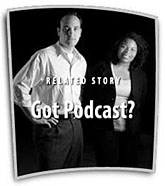
eaching my music education class online a few semesters ago was quite an experience. If you had told me two years ago that there was such a thing as “cyberspace worship,” I would not have believed it. How could this be or even happen? Well, it happened to me one morning!
It was Friday, January 24, 2004.
My lecture focused on the opera Dido and Aeneas, written by the distinguished British composer Henry Purcell. The assignment was to extrapolate the historical and musical significance of this work, more specifically the musical function of the ground bass in “Dido’s Lament.” For those of you who are not familiar with this work, the “Lament” is built on a ground bass—an ostinato passage about five measures in length—that repeats 11 times throughout the work. It really anchors the work beautifully—giving unity as well as holding the work together—in such a way that its simplicity defies explanation.

Before I go any further, let me explain how it all started. Integrating faith and learning into the online experience is something that I learned from taking the “Active Online Teaching” class via Andrews University in Berrien Springs, Michigan—though, not in the way you will experience by reading this article. Integrating faith in the online classroom was a strange concept, but Melvin Northrup and his online instructors—prayer warriors—took the idea seriously and made me realize that it was possible to integrate this concept into the online arena.
As a lead-in into the online discussion of the “Lament,” I placed my “Thought for the Day” on my online whiteboard for all the students to see.
I do this to begin all my online classes. What I had on the whiteboard was as follows:
THE FOUNDATION
“Therefore thus saith the Lord God, ‘Behold I lay in Zion for a foundation a stone’” (Isa. 28:16).
Of all the gracious promises concerning the children of God none is more wonderful than that which describes the saints as polished stones in the temple where He dwells. With divine grace, our Lord calls Himself “the Foundation,” an “everlasting Rock,” “the Rock of Ages.” Where stands our faith today? Are we building upon the sands of human philosophies, or upon Him? “On the Rock of Ages founded, naught can shake our sure repose.” (Taken from The Wonderful Names of Our Wonderful Lord, by Charles E. Hurlburt.)
By the time I had written the “thought” on the online whiteboard and then entered the discussion room with my usual expression, “please read the ‘thought for the day,’ and ponder it for a moment,” the students were already sending their comments to each other. Their comments ranged from “On Christ, the solid Rock I stand,” to “Jehovah hide me, I am under the Rock,” and “O safe to the Rock that is higher than I.” You probably recognize these as phrases taken from historic Adventist hymns, of which we do not hear too many these days. Soon the online conversation took another direction as students began to ponder and reflect.

One student expressed his thoughts by writing, “It is truly wonderful that the Master of the universe and beyond esteems us so. That we should be called the sons of God. His promises are precious and new every morning.”
Another student, whose first language is not English, piped in, “. . . for in human nature, there is nothing that can bring us closer to Him. Therefore, why not look up to the Rock of ages, from whom all blessings flow.” This same student continued, “I would even say He is my Roll!”
I asked, “What do you mean by Rock and Roll?”
She replied, “Roll as in bread,” while another student quickly typed in “Living Bread.” After further comments by various students we all came away knowing that she meant the Lord is my Rock and also my Roll (the Living Bread). He is solid but also soft. He is full of discipline and yet full of compassion.
“What a beautiful metaphor!” stated another student, an exclamation that was punctuated by “Amen,” “My Lawd,” “Help us, Lawd!” and many declarations of “Have mercy!”
After prayer by one of the students, I could not help marveling at what was scrolling across my computer screen. The student’s prayer was thus:
“We appreciate the opportunity that is ours to know You better here at Oakwood College. We welcome Your presence into this class today. We appreciate Your sacrifices for us way back on Calvary. We would ask now that You would redeem the next few moments that we spend in this virtual classroom, but in Your very real presence. And somehow interpose Your divine ability to make clear every word. Now we pray to You because we know You can bless us in our individual need. You know all about my classmates who are concerned, or perplexed, or weighed down. Set free.”

At this point, a student interjected into the prayer “We welcome You, Holy Spirit.” The prayer continued. “We ask all these blessings in the matchless name of Jesus . . . and count them done. Amen” [unedited].
I usually follow the prayer by moving ahead with my lecture, but what followed next was what I have seen on several occasions in many live worship services across the United States—but not in an online classroom. “You’re worthy,” wrote one student, which was then followed by various online outbursts of expressions ranging from “Alleluia,” “We adore You, Father God,” “We bless Your name,” and “Thank You, Jesus.” Much giving of thanks and praise then followed all of this.
I looked at my computer screen but was unsure of what to do next. A worship experience of some sort was unfolding right before my eyes, but I knew I had to get my class through the discussion assignment. I needed also, however, to allow what had happened to ebb. After what seemed like a very long pause—it took a moment before I could get the class back on track—we went back to the classwork, but that did not happen without the goodness of the Lord popping up in the discussion. Wow! No organ or piano playing. No choir or soloist singing. In the purest sense, there was the written Word, prayer, testimony, and the role of the Holy Spirit.
The discussion that ensued—which also dealt with musical foundations such as the ground bass used in Dido’s “Lament”—went exceptionally well, or as stated by the students, “True learning actually took place today!”
This was an experience I won’t easily forget, and one that points all of us toward using cyberspace for the integration of faith and learning.
____________
Audley Chambers is associate professor of music history and literature and chair of the Music Department at Oakwood College in Huntsville, Alabama.

 Before I go any further, let me explain how it all started. Integrating faith and learning into the online experience is something that I learned from taking the “Active Online Teaching” class via Andrews University in Berrien Springs, Michigan—though, not in the way you will experience by reading this article. Integrating faith in the online classroom was a strange concept, but Melvin Northrup and his online instructors—prayer warriors—took the idea seriously and made me realize that it was possible to integrate this concept into the online arena.
Before I go any further, let me explain how it all started. Integrating faith and learning into the online experience is something that I learned from taking the “Active Online Teaching” class via Andrews University in Berrien Springs, Michigan—though, not in the way you will experience by reading this article. Integrating faith in the online classroom was a strange concept, but Melvin Northrup and his online instructors—prayer warriors—took the idea seriously and made me realize that it was possible to integrate this concept into the online arena. One student expressed his thoughts by writing, “It is truly wonderful that the Master of the universe and beyond esteems us so. That we should be called the sons of God. His promises are precious and new every morning.”
One student expressed his thoughts by writing, “It is truly wonderful that the Master of the universe and beyond esteems us so. That we should be called the sons of God. His promises are precious and new every morning.” At this point, a student interjected into the prayer “We welcome You, Holy Spirit.” The prayer continued. “We ask all these blessings in the matchless name of Jesus . . . and count them done. Amen” [unedited].
At this point, a student interjected into the prayer “We welcome You, Holy Spirit.” The prayer continued. “We ask all these blessings in the matchless name of Jesus . . . and count them done. Amen” [unedited].